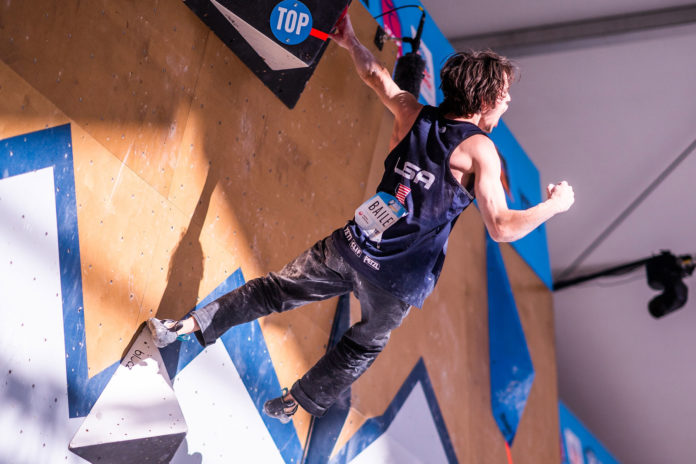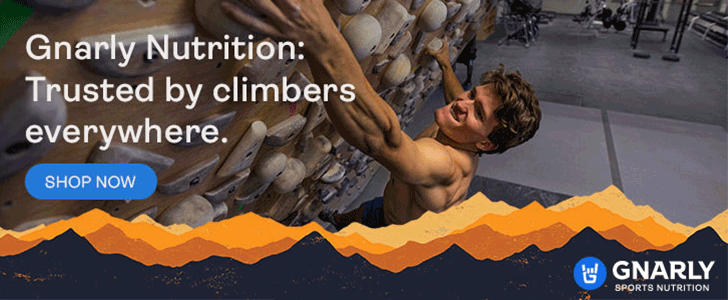This story is the second chapter of a five-chapter series on Professional Routesetting: The Truth Behind the Trade by Dave Wetmore. Scroll to the end of the article for bios of routesetters interviewed.
Read More Chapters of Truth Behind the Trade
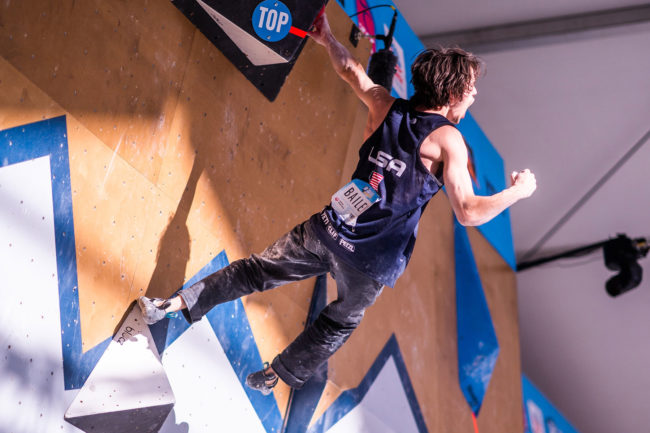
On May 30th, 2021, Natalia Grossman and Sean Bailey swept Gold at Salt Lake City’s Bouldering World Cup finale. Tens of thousands of people that night were enraptured by the mesmerizing performances of these two historic champions. But at the venue and online, I know most viewers were transfixed on how painstakingly boring and useless two of the Men’s Finals problems were. No one could do them. As a setter for the event, apart from a few choice moments, observing our work unfold that night was like watching a slow train crash.
Six of the best male boulderers in the world couldn’t get past the first move, just inches above the pads. Thirty minutes of silence passed. And then it happened again on the next problem. Each flatlining moment felt like a vice slowly tightening down on my temples.
Routesetters cannot control the outcome of any given round, but in this situation our choices clearly led us astray. I felt like we had missed the mark and would have to wait another year, burdened by an inescapable feeling of failure, until sweet redemption hopefully made its way back around the following season.
At 4 a.m., after the event’s conclusion, I found Jamie Cassidy, IFSC Chief Setter, outside on the back porch feverishly inhaling yet another Marlboro Red―white smoke swirling out of his nostrils and mouth like a ceaseless smokestack. With each heavy drag, the red-orange amber glow illuminated the deepening lines on his face and the graying beneath his long black hair. He looked tired and uneasy.
I walked over to him across the deck to say goodbye, but he spoke before I could open my mouth. “I have never been more embarrassed in the 20 years that I have been setting World Cups than I am right now,” Jamie said to me with stone-cold eyes, cracking open another Coors as he stood alone outside in the early morning’s purple dawn.
Between the two of us in the quiet morning hours out on that deck―away from the crowd, the cameras, the commentators and, above all, the athletes―I understood exactly what he was feeling. The stress of competition routesetting is enormous. Regret. Missed opportunity. Post-comp setter blues, and not the nostalgic kind―the kind that makes you feel like you wasted an entire week and leaves you wondering if you’ll ever get the chance to set again for the best in the world.
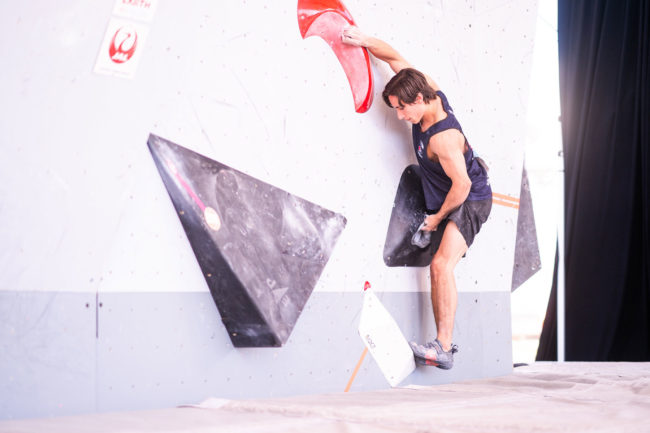
When routesetters do a good job separating the field, nobody notices. However, when routesetters do a poor job―have lots of ties, no tops, too many tops, bottle-necks―everyone notices immediately. At the end of the day, given the fact that we are not masterful magicians pulling at some invisible performance strings, our part in the game of competition climbing is really just an educated guess.
Jamie and I shook hands and parted ways. Who knows if we’ll ever see each other again. It was at that moment that I again asked myself deeper questions about routesetting as a profession in general: How long can Jamie go on doing this? How long can I go on doing this? Why do we keep doing this? What is the lifespan of the competition setter? What about the commercial setter? Is modern-day, full-time “professional” routesetting a sustainable career path? And who really wants to do it forever?
Josh Larson―the USA National Team Head Coach, a USAC Level 5 National Chief Routesetter, and a good friend of mine― texted me the next morning, in his usual straight-to-the-point, no-nonsense manner: “I know it didn’t go the way you planned, but that’s the dice we roll. If it was clear cut and easy to do, it wouldn’t be fun.”
It’s true, the challenge of routesetting―whether it be separating a field of competitors or pleasing clientele at the gym―is part of the fun, and it can even be addicting. But like all addictions, at a certain point you either crumble underneath the weight of them or revise your core self and environment to address the issues that are holding you down.
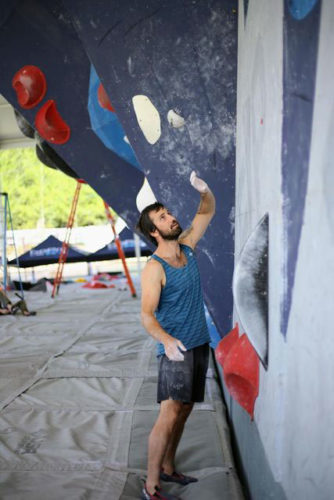
Discovering the Unknown Art of Creating Movement
I was an eight-year-old playing NHL94 on Sega Genesis when my Dad asked me if I wanted to try climbing at the gym down the street. We grabbed some Dunkin’ Donuts and went to the Boston Rock Gym—a small, grassroots climbing hideaway that is now a link in a gym chain, much like many first-generation climbing gyms across the country. And while bigger gyms mean that more people are introduced to the sport every year, the effects of a constantly evolving market aren’t always exactly felt equally.
Of course, as a kid with no sense of these impending economic and moral dilemmas, my biggest worry that day was simply learning how to tie a figure-eight knot and belay with an ATC.
After thrashing myself up just one top-rope, I was hooked. I remember thinking, “Wow, this is a thing people actually do? You can climb around all day on plaster-covered walls with crazy-looking rocks sticking out?” I felt like such a rebel, hucking myself from one hold to another, 30 feet above the rubber-chip covered floor.
As a kid climbing for the first time, I wasn’t contemplating the quality or intricacy of each move. I wasn’t thinking, “Is this reachy? Thuggy? Delicate? Is this fair and functional? Am I light or heavy today? How about dynamic? Is it banger? Or fire? It’s totally soft, dude. Maybe sandbagged too. Wait, is my iPhone rolling?” No, none of these superficialities had leaked into my climbing subconscious yet. I was just trying to go up—maybe even get to the top if I was lucky or my Dad pulled up too much slack.
Today, this experience is replicated all over the country, hundreds of times a day. Like many others new to the sport, I didn’t understand at the time that all the little rocks we climb are carefully arranged by strange folks called routesetters. To put it in much fancier terms, modern routesetters like to call these little rock climbs the product. It’s no secret that selling quality movement is important to overall gym performance. But how much should we really be stressing over the minutiae of each new boulder or route?
Making Great Sandwiches
Since rock gyms aren’t created for charity, but for profit, the main goal of the routesetter—other than being a tormented artist obsessed with climbing—is to put things up on the wall that people can climb and that make them want to come back.
While management and staff are essential to operations, routesetters are the ones behind the scenes―the engine driving the machine forward―who are responsible for the movement that each facility sells. We are the slow-moving, juggernaut-horde of drill-laden, crusty climbing misfits who are constantly stripping and crawling behind dusty walls, washing holds, maintaining hardware, and creating new moves for the masses.
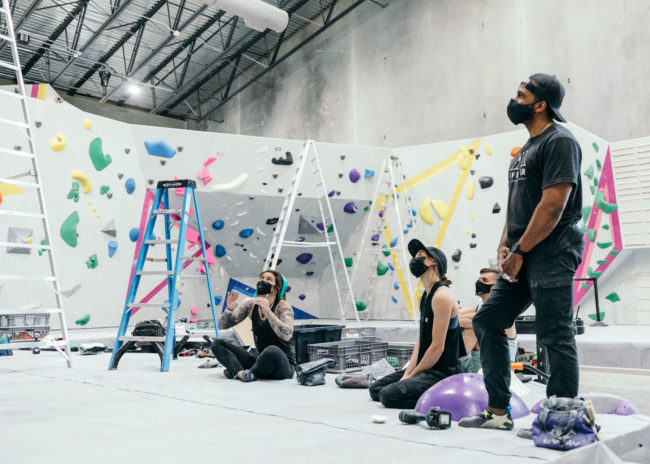
Everyone likes to use the metaphor that climbing gyms are like restaurants: The setters are to the climbs as cooks are to the food, except that in restaurants you are tasting the experience. And like with food, how you experience what you’re consuming depends greatly on your experience level. Take wine for example. Unless you’re a seasoned connoisseur, the difference between one red wine and another is hardly noticeable, and the same may be said for routesetting. Most climbers are probably happy to consume most everything that they can go up on. This begs the question: How good does the routesetting really have to be at the end of the day to attract and retain new customers?
“If something sucks, they’re gonna’ notice that naturally, without necessarily being able to articulate it. If something is off, new climbers will just feel it and think, oh, that wasn’t fun. So, I think it does matter. I think you do need to have a good product at the gym to be successful,” says Brad Weaver, another USAC Level 5 Chief who has been setting for nearly 20 years.
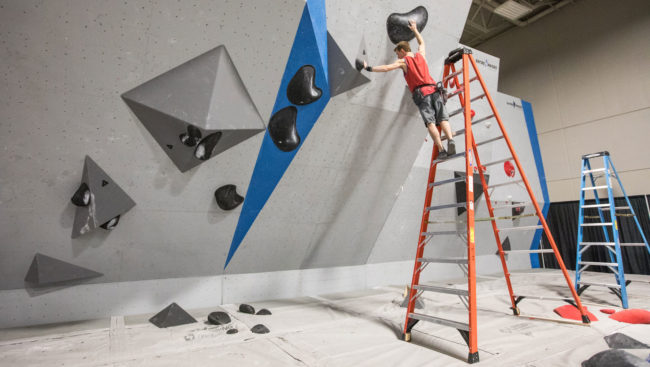
While I agree that routesetting is a key component of consumer satisfaction, I’m still unsure about how much we should stress over it.
Mountain Helt, who has been setting in commercial gyms since the 90s and is also a USAC Level 5 Chief, says, “We all need to chill out and let go of this perfectionist attitude towards the work we do. Each route or boulder doesn’t have to be a masterpiece. I don’t think it’s as important as everybody makes it out to be. People overblow what that experience actually is for the customer.”
Instead, Mountain believes in his “sandwich” philosophy, which rings true to my experience as well:
“People always compare rock gyms to five-star restaurants. I think a commercial climbing gym is more like a deli than a five-star restaurant,” explains Helt. “What we’re doing is just creating some really nice sandwiches. Everybody likes a PB&J. Sometimes they like a sexy deli sandwich with spicy mustard, but it’s still just a freakin’ sandwich. So don’t spend three hours on this route. I just need a turkey sandwich. Because if you look at the memberships, which commercial setters never want to do, you’ll see that most people climbing these days have very little experience. People want to come in and grab holds for two or three hours with their friends, get a workout, and then go home. And hopefully they come back and buy another sandwich. I would rather make a really awesome jug haul―a membership maker―than some amazing, creative five-star meal. As the Head Setter, your job is to teach your setters how to make great sandwiches.”
A Few of the Key Ingredients
No matter the gym, knowing who you’re setting for is key to making those great sandwiches.
“The goal of routesetting is to make the community happy. I view a lot of what I’m doing as a routesetter as customer service. Really, at the end of the day, it’s all about customer service. Indoor rock gyms are selling people, plastic and programs, and not necessarily in that order,” adds Molly Beard, a USAC Level 5 Chief and setting since the 90s herself.
“Successful commercial setting programs will identify the user groups in the gym and make sure those groups’ needs are being met. This means a variety of appropriate climbs for each group to warm up on, climb, and project,” says Jackie Hueftle, a longtime commercial setter as well, CWA Routesetting Committee member, and co-founder of the Routesetting Institute.
One of the best ways to check the quality of a new set for your customers is to simply observe how they interact with it.
“I spend time afterwards, just sitting around watching people climb. What do they like? What don’t they like? It’s a fast piece of information that I get back,” confirms Beard.
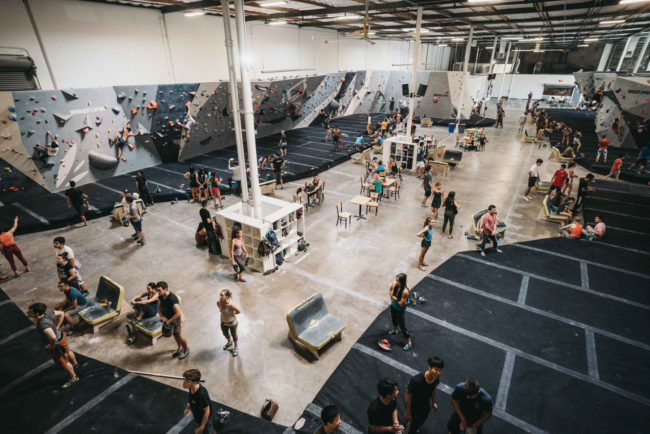
Today, routesetting management software is a common fixture of gym climbing culture. This means that outdoor climbers are no longer the only tribe that can rank themselves. Indoor climbers now too have a place to share their beta and sends within their individual communities. While giving climbers another place to share fitness strategies and provide feedback can be helpful in acquiring useful data―as well as tracking grade spreads and section turnover dates―I believe it will always be important for successful routesetting programs to continue leveraging simple observation and in-person communication.
“This is probably a generational thing, but I would rather just talk to somebody about what’s going on with a route or if they have a disagreement about a given grade,” agrees Beard.
Setting management style aside, most people can probably agree that high-quality setting does matter, perhaps especially in more competitive gym markets. Good routesetters make the production of good routesetting look easy. But in reality, it takes a very skilled, trained and creative person to routinely put up climbs that are well-rounded, well-liked, and hit the grade or circuit for a variety of different people.
Perhaps most important, and hard to assess, is the setter’s comprehension of movement.
“In order to understand how to set in a way that is either fun or pleases a specific clientele or a crowd or a competitor, the setter has to develop a strong understanding of climbing movement itself. This means not only an understanding of basic technical skills, but how to create those movements consistently, fluidly, and with a strong base of knowledge regarding difficulty. This doesn’t happen overnight, that’s clear. But what’s messy is that, in comps or in gyms, the judgment of what or who is ‘good’ is also incontrovertibly subjective,” elaborates Chris Danielson, an IFSC Chief Routesetter, USAC Level 5 Chief, and owner of Thread Consulting with decades of setting experience.
Consequently, given the myriad factors that comprise the craft, the path to routesetting mastery is long and complicated, and the recipe for a successful career is always evolving in tandem. In the next essay, we’ll explore the career path of the modern-day commercial gym setter, and the role USAC competitions, clinics and certifications have played in its evolution.
Read More Chapters of Truth Behind the Trade
About the Setters
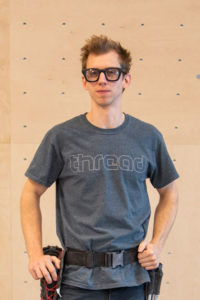 Brad Weaver
Brad Weaver
Brad is a Level 5 USAC National Chief Routesetter and IFSC Junior Routesetter who previously developed and managed the routesetting program for the Stone Summit chain of gyms in the Atlanta area until 2019. Brad has worked at each USAC National Championship competition in the past decade―adult and youth, bouldering and lead―and has set numerous international competition events and youth competition training camps. He now works with his colleague Chris Danielson at Thread Climbing.
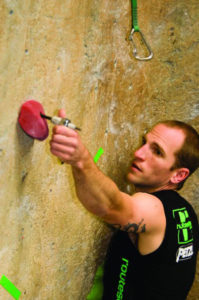 Mountain Helt
Mountain Helt
Mountain Helt (formerly Mike Helt) has been a pro-setter since 1995. He founded the influential website, Routesetter.com, as well as Climbing Business Journal. Mountain helped create the current USAC setter certification system and was a lead instructor for over ten years. He is a USAC Level 5 National Chief and since 2007 has set numerous IFSC World Cups and National championships. He currently lives in Reno where he is the co-founder of Mesa Rim Reno and serves as its Head Setter.
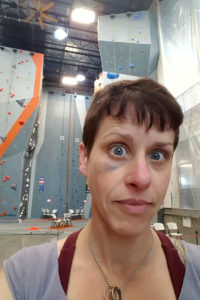 Molly Beard
Molly Beard
Molly started climbing in 1993 and began routesetting in 1995 after getting involved with a youth climbing team. She became the first U.S. woman to earn L5, chiefing three Youth Nationals in 2008-2009. She loves Mexican cuisine, BJJ, Hello Kitty, and chainsaws almost as much as her impact driver.
 Jackie Hueftle
Jackie Hueftle
Jackie Hueftle has been routesetting since 1998 and has been a USAC Level 4 setter since 2008. As a young competitor she represented Team USA at Junior Worlds and since then has coached for and set numerous competitions of all levels, including three years as chief of Womxn Up and several years as Head Setter at The Spot in Boulder. She is the owner of Kilter Grips, co-founder of The Routesetting Institute, a member of the CWA Routesetting Committee, and part of an International effort to professionalize routesetting.
 Chris Danielson
Chris Danielson
Chris has been climbing and setting since the early 90s and has worked at the highest level of competitions for nearly 20 years, most recently as the Chief Routesetter of the 2021 Moscow IFSC Bouldering World Championships. He is the owner of Thread Climbing, a leading climbing holds distribution company based in Boulder, Colorado, and has experience in many aspects of the industry, including federation work, gym start-up and design consultation, athlete training, and commercial setting and education.
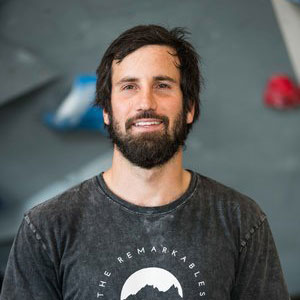
In the early 2000’s, Dave started screwing things to the walls inside of his shed. Two decades later, he is still doing the same thing, only on slightly nicer walls with more advanced materials. After studying journalism at the University of New Hampshire, he unwittingly fell into the then emerging trade of routesetting. These days, he fancies himself a writer and hopes that his stories might help others shift their perspective or share a laugh, or both. Dave is currently the head setter of The Boulder Field in Sacramento, California, and has been published in Climbing, Rock and Ice, Experience, and Urban Climber, among others.



